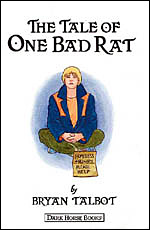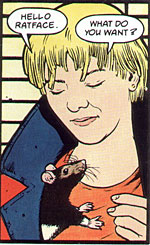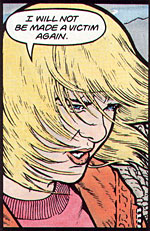>> The Friday Review: The Tale Of One Bad Rat
>> The Friday Review: Cathedral Child
More...

 Writer/Artist: Bryan Talbot
Writer/Artist: Bryan Talbot
Collecting THE TALE OF ONE BAD RAT #1-4 (Dark Horse)
Price: £9.99
Publisher: Titan Books (January 1996)
ISBN: 1-85286-689-6
When people find out that I "still read comics at my age", one question that often comes up (among those people who can wrap their head around the concepts that we're not talking about THE BEANO, and that there're comics about people with their underwear on the right side of their trousers), is what I'd recommend to someone curious to try reading a graphic novel for the first time.
So, what to suggest as a serious piece of work about a serious subject, but just as importantly, one tackled in such a way as to avoid the elements and aspects of comic storytelling that often convince the casual observer of an intrinsic childishness in the medium?
Without fail, I always refer to Bryan Talbot's THE TALE OF ONE BAD RAT.
ONE BAD RAT's central theme is that of coping with child abuse. It tells the story of teenage runaway Helen Potter as she flees her toxic domestic environment that's been polluted by sexual abuse from her father.
Helen is a sensitive child, who takes refuge in the works of children's author Beatrix Potter. Like many victims of abuse, Helen believes herself to somehow be to blame for what happens to her; unable to comprehend that the father she initially idolises could be the one in the wrong.
At the same time, Helen identifies with her rat companions (whether real or imaginary) and defends them against the preconceptions of others that they are dirty and vicious animals to be despised. She sees them as far more sympathetic creatures, giving them benign yet mischievous personalities in the manner of Beatrix Potter herself.
Just as she knows that the rat is unfairly blamed and scapegoated, she takes a psychological journey (in parallel to her physical pilgrimage across England to Potter's home in the Lake District) to prove to herself that she too isn't really the Very Bad Rat she perceives herself as.
 Getting the central message across as clearly as possible is Talbot's primary concern. He mainly sticks to simple grid patterns, but within these structures there are also plenty of more sophisticated techniques to admire. Helen's troubled visions allow depictions of nightmarish giant cats and skies shattering like mirrors, while the behind-panel backgrounds darken to an ominous black during the frequent flashbacks that gradually flesh out the details of Helen's previous damaged home life.
Getting the central message across as clearly as possible is Talbot's primary concern. He mainly sticks to simple grid patterns, but within these structures there are also plenty of more sophisticated techniques to admire. Helen's troubled visions allow depictions of nightmarish giant cats and skies shattering like mirrors, while the behind-panel backgrounds darken to an ominous black during the frequent flashbacks that gradually flesh out the details of Helen's previous damaged home life.
There's also a whole section given over to a complete 40-page pastiche of a Beatrix Potter story, the whimsical nature of which is a nice juxtaposition against Helen's somewhat harsher situation.
The fact that scenes of Helen overlooking the muted greens and grey of Coniston Water, while holding a conversation with a giant imaginary rat look neither ridiculous nor out of place is testament to Talbot's ability to meld the mundane and the fantastical. Suspension of disbelief is never compromised.
But in the main, the art is firmly grounded in reality. Talbot utilised vast amounts of photo-reference of people and locations in order to imbue ONE BAD RAT with as high a level of visual authenticity as possible. The tranquil majesty of the Lake District in particular is accurately and beautifully captured, with Talbot's love of the area (the starting point for this story was simply to set something in the Lakes) shining through.
Being both writer and artist, Talbot knows what techniques to use for what situations and isn't afraid to let the art "speak" for itself. A wordless six-page chase scene through London traffic is the most striking - but by no means only - example of Talbot showing the reader what's happening, rather than telling. He also deliberately eschews the use of such juvenile elements as sound effects and thought bubbles (using the presence of Helen's rat companions to allow her to voice her thoughts) to ensure that the storytelling maintains an air of maturity.
The meticulous attention to detail and subtle symbolism in the art are other remarkable aspects of the work. As Helen runs away she hacks off her long blond hair, symbolically putting her days as her Father's "little blondie bombshell" behind her. The regrowth of the hair during the story not only reflects her recovery, but is also depicted at a realistic rate as Talbot went to the trouble of consulting with a hairdresser in order to get it right!
At another point, Helen is singing the old "One For Sorrow, Two For Joy" song to herself, only for seven Magpies to take wing in the background during a later scene where she's recounting the details of her own "secret never to be told". While not being absolutely essential to the telling of the central story, touches such as these add an essential realism, and a richness that rewards repeated reading.
 However good the visual aspect of the storytelling though, ONE BAD RAT wouldn't work without Talbot's equally deft scripting. The story is always moving forward as Helen reconstructs her life, and maintains the reader's interest in her progress. The dialogue too sounds very natural, with Talbot often going as far as to allow actual real-life victims to "speak for themselves" by paraphrasing their words when Helen is discussing her feelings and experiences.
However good the visual aspect of the storytelling though, ONE BAD RAT wouldn't work without Talbot's equally deft scripting. The story is always moving forward as Helen reconstructs her life, and maintains the reader's interest in her progress. The dialogue too sounds very natural, with Talbot often going as far as to allow actual real-life victims to "speak for themselves" by paraphrasing their words when Helen is discussing her feelings and experiences.
ONE BAD RAT is often credited with helping abused young people come to terms with what they've suffered, so I thought it would be interesting to get some first hand comments from some of my partner's social work colleagues.
Quite apart from praising the mature and sensitive handling of the sexual abuse elements, they were also impressed to see the often-ignored topic of child homelessness being addressed. The general feeling was that ONE BAD RAT would indeed be useful in enabling victims to open up about their experiences, especially as it links a disturbing adult theme with non-threatening aspects such as the Beatrix Potter references. Also, Helen seeking out self-help books and making progress in dealing with her experience was seen as an empowering act that might inspire survivors to emulate her.
Given a dearth of appropriate literature for teenagers, there was great interest in where copies of ONE BAD RAT could be obtained. I just hope I'm there to see the reaction in my usual superhero-oriented comic shop when they get a bulk order from the local Social Services department.
However, as laudable is this is, A TALE OF ONE BAD RAT is primarily a fictional entertainment, and not a self-help book. It's an absorbing tale of a thoroughly likeable and sympathetic character, put through an authentic series of trials before coming to a conclusion that leaves the reader hopeful for better days ahead. The storytelling is both clear and subtle, not to mention brilliantly realised in some genuinely beautiful artwork. Bryan Talbot is undoubtedly One Clever Rat.

This article is Ideological Freeware. The author grants permission for its reproduction and redistribution by private individuals on condition that the author and source of the article are clearly shown, no charge is made, and the whole article is reproduced intact, including this notice.


